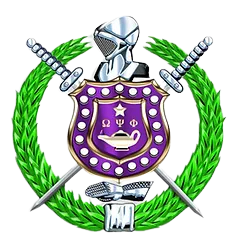The History
THE HISTORY OF OMEGA PSI PHI FRATERNITY, INC

THE BIRTH OF OMEGA:
After meeting on different occasions during the Autumn months of 1911, Edgar A. Love, Oscar J. Cooper and Frank Coleman converged on the office of Professor Ernest E. Just for a most important meeting to hash out the plans for a Greek letter fraternal organization for Negro men, as they were then called. This meeting, which was not the first with Professor Just, but arguably the most impactful, occurred on a rainy Friday evening on November 17, 1911. With temperatures in the mid 40s, the three nattily dressed Howard University students bundled up and traipsed across campus under a dark sky to Professor Just’s office in hopes of benefitting from his sage counsel and convincing him to be their advisor. Love, Cooper, and Coleman were budding scholars who excelled in their chosen fields of study. Love, a sophomore, had his eye on the ministry, while Cooper, a junior, endeavored to become a physician and Coleman, also a junior, displayed a knack for physics.
Convinced that the three enterprising young men were serious, the biology professor, a young man of only twenty-eight years of age himself, signed on as their faculty advisor, thus giving birth to the Omega Psi Phi Fraternity [now The Omega Psi Phi Fraternity, Inc.] “Friendship is essential to the soul,” was chosen as the fraternity’s motto.
Manhood, Scholarship, Perseverance, and Uplift were adopted as the fraternity’s Cardinal Principles. Before the meeting was adjourned, a decision was made regarding the design for the pin and emblem, thus giving rise to one of the most striking and recognizable shields of any college fraternity.
A follow-up meeting occurred on the 23rd of November, just days before Thanksgiving break. At that meeting it was decided that Edgar A. Love, the youngest of the three students would be the first Grand Basileus (National President). Cooper and Coleman were selected as Grand Keeper of Records (National Secretary) and Grand Keeper of Seals (National Treasurer), respectively. Between December 2nd when school resumed and the 14111,eleven undergraduate men were selected as charter members, culminating in the establishment of Alpha Chapter with a total of fourteen members, on December 15, 1911. Including the founders, were William Gilbert, Charles Y. Harris, Clarence A. Hayes, Benjamin A. Jones, Clarence 0. Lewis, William H. Pleasants, Charles B. Washington, Edward P. Westmoreland, Frank H. Wimberly, and of course the Love brothers-Julius H. and William A., thus becoming the first family of Omega. Months later, four more men were initiated into Omega-James Raymond Johnson, William B. Jason, Moses Clayborne and Christopher C. Cook.
As the months passed, and the building of The Omega Psi Phi was well on its way, the Brothers of Omega suffered disappointment. On March 8, 1912, the previously submitted fraternity constitution was rejected by Howard University administrators, yet the Brothers of Omega refused to give in. That same day, US Army Col. Charles Young was elected the fraternity’s second honorary member, with Professor Just being the first, of course.
Is it possible that Howard University’s other fraternity wanted a monopoly on the school’s young men, thus feared the competition? Whatever the case, the fraternity was authorized to function as a local, not a national organization. Undeterred, the young men pushed forward, refusing to accept the terms dictated to them. Overcoming one trial and tribulation after another, over the next week or so, the men of Omega finally convinced the faculty and administration of the merits that is a national organization afforded both its members and the university. To be clear, it was through the power of persuasion, perseverance, and the behind closed-doors assistance of Professor Ernest E. Just, that the men of Omega, eventually prevailed, making the Omega Psi Phi Fraternity, the second Black Greek letter fraternity on Howard’s campus, but the first Black Greek-letter fraternity founded at Howard University.
However, it would be more than two years later (on October 28, 1914) before the fraternity was incorporated by the United States Congress under the laws governing the District of Columbia.
In the interim Oscar J. Cooper became the fraternity’s second Grand Basileus (1912), and not long after that authorized the investigation of a proposed second chapter at historically Black Lincoln University in Pennsylvania.
Edgar Love returned to the position of Grand Basileus for the second time in 1913 and served until 1915. During Love’s tenure, Lincoln University’s Beta Chapter was chartered in February 1914.
George E. Hall, the fourth Grand Basileus and Alpha initiate, authorized the establishment of Gamma Chapter in Boston Massachusetts, in 1916, although it came to fruition under the administration of James C. McMorries, the fraternity’s fifth Grand Basileus. The “War Chapter” at Fort Des Moines was organized that year as well.
During the administration of the sixth Grand Basileus, Clarence F. Holmes, Otto Bohannon penned “Omega Men Draw Nigh” the fraternity’s first official hymn.
Raymond G. Robinson, the seventh Grand Basileus, established Delta Chapter in Nashville, Tennessee, home to Meharry Medical College, in 1919. By the time Robinson left office in 1920, there were tenfunctioning chapters.
Stanley Douglass served as editor of the first Oracle published in the spring of 1919.
Harold K. Thomas, the eighth Grand Basileus, was elected at the 1920 Grand Conclave in Nashville, Tennessee. It was at this Grand Conclave that Dr. Carter G. Woodson inspired the establishment of National Achievement Week to promote the study of Negro life and history.
The 1921 Atlanta, Georgia Grand Conclave brought to an end the first decade of the Omega Psi Phi Fraternity, Inc.

